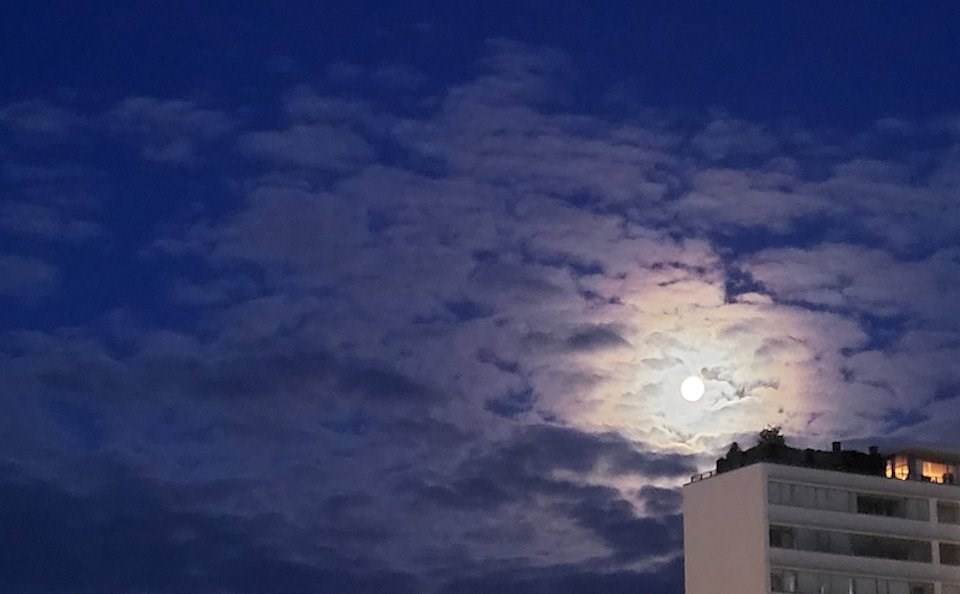Locals captured whimsical images of rainbow 'moon halos' on billowy clouds this week.
Following a long run of tempestuous Vancouver weather, the skies cleared this week, providing the ideal viewing conditions on the on Tuesday, March 7.
While there were some clouds in the sky, they didn't impede many lunar viewing opportunities. In fact, the cloud cover provided the perfect canvas for mother nature's celestial paintbrush early Wednesday morning.
Moon reflections were spotted on puffy white clouds along with what appeared to be a colourful halo around the heavenly body. Multiple people shared images of the rare sight, commenting that it was a welcomed sight after a string of gloomy days.
Environment Canada meteorologist Derek Lee told V.I.A. that the full moon was very bright last night but the clouds were "mid-level." By the early morning, the clouds were higher in the sky, which would have created the ideal conditions for refracting light.
While low-level clouds produce rain and snow, clouds located higher in the sky, especially ones with significantly higher altitudes, may contain ice crystals. When light shines on these crystals, the refracted light can take on a variety of hues like that of a prism, he explained.
Lee added that there is a possibility that the colours in the images result from a lens flare, but that it is likely that the photos show light reflecting some sort of precipitation.
Vancouver weather created ideal conditions for rare lunar spectacle
While some people may confuse the colourful manifestation as a "moonbow," H.R. MacMillan Space Centre Astronomer Marley Leacock told V.I.A. that this phenomenon takes place in the sky opposite the moon.
"[A moonbow] is formed by light being reflected and refracted in suspended droplets of water," she explained, noting that they are "typically very faint and difficult to spot."
Instead, the astronomer believes locals captured evidence of a "lunar corona," which is caused by the diffraction of light through small water droplets and sometimes tiny ice crystals.
"There are several concentric pastel-coloured rings, and a central bright spot. That central bright spot is over the moon and the surrounding clouds (especially noticeable in the second image). That bright spot is called an aureole," she described
Leacock said a lunar corona is similar to a lunar halo but the latter is "typically a thinner band of colour (or they appear white), and are caused by ice crystals rather than water droplets.
Have a look at some pictures of the rare lunar spectacle.
Good morning Wednesday!
— Michelle Valancius (@howyougo)
My feeble attempt to capture the moon at 3:58 this morning.
— Stephen Quinn (@CBCStephenQuinn)
Bark at the moon!!!!
— BARRY ALLEN (@mikep75446070)
6am moon……
— Colleen Lee ?? (@CoLeeSensei)
Good morning, gang
— Jon Binary (@MachetePanzone)
Full moon ?
Have a great day
????
Hey how cool is this moon shot inside the clouds ! ?
— ??TheFlashVibes?? (@aveiestweets)
Something really soothing to see the full moon after so many days of overcast skies.
— David Chen, concerned citizen 陳冠余 (@DavidChenTweets)
What an amazing night... full moon .. love you all ??????
— Tender ASMR (@JamesNe66808118)
Took some moon pictures on the way to my car.
— Tequila BLM Mockingbird (@KingofQueens13)
The moon looks amazing tonight.
— Ray Gaur (@raygaurca)
The moon looks amazing tonight.
— Ray Gaur (@raygaurca)
Caught a gorgeous moon rise this evening on a walk with a friend. It lifted my spirits for a brief moment.
— Jessica Lu | 呂明潔 | ???? (@JessMLu)




